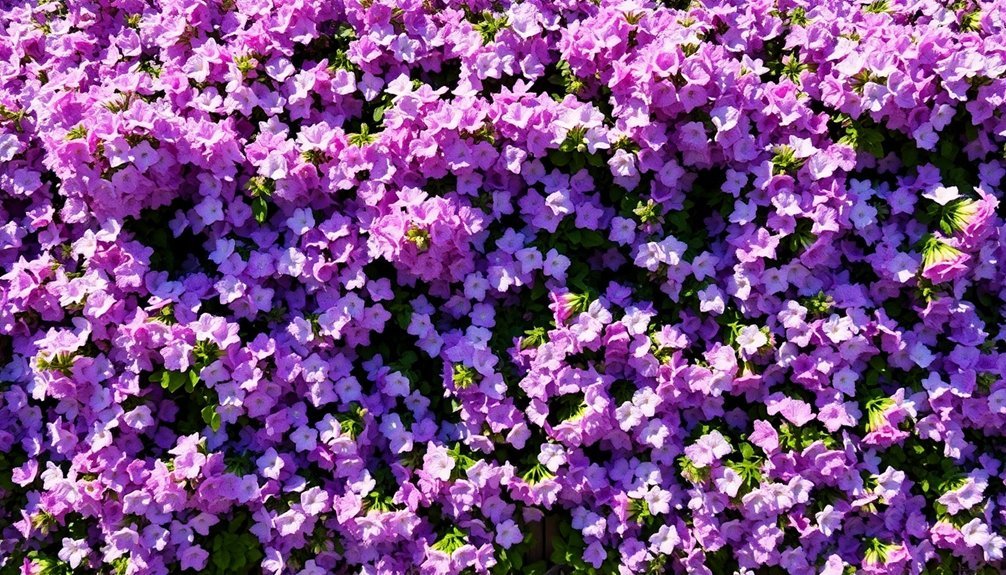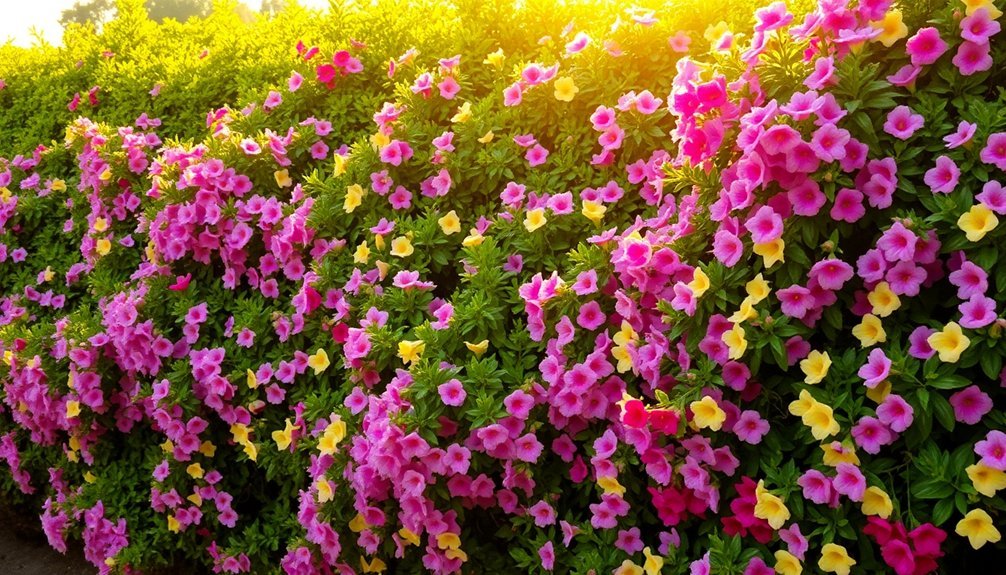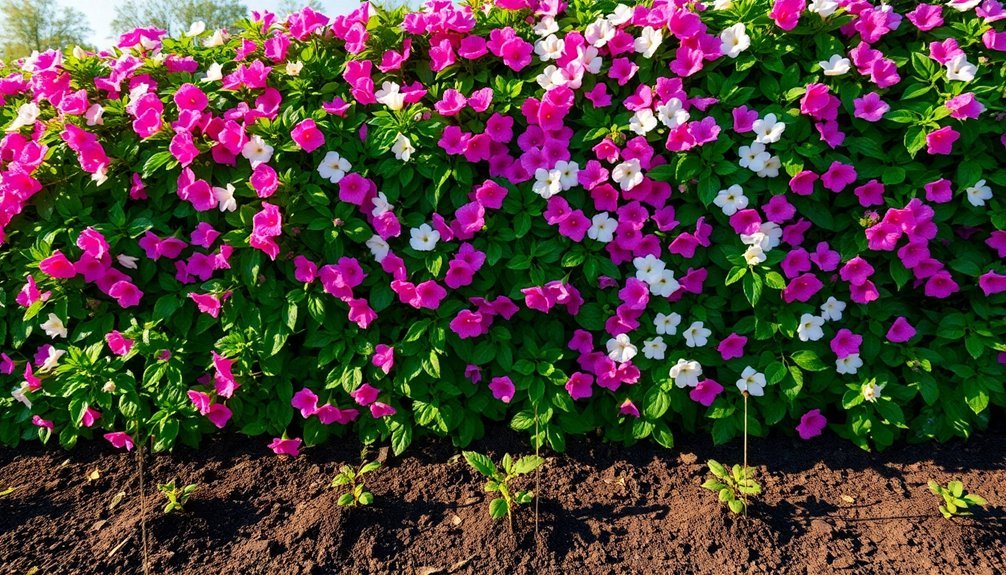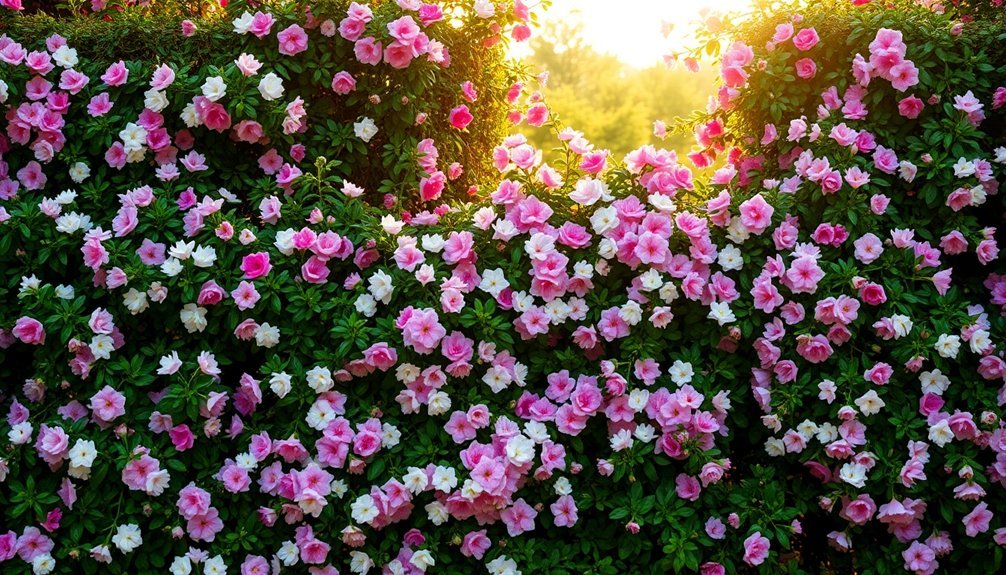Flowering hedges provide privacy while enhancing your garden's beauty and attracting beneficial wildlife. Fast-growing options like forsythia, crapemyrtle, and viburnum can add over 24 inches yearly with proper care. Plant them in spring using straight lines with 60-100cm spacing in slightly acidic soil. Apply high-nitrogen fertilizer for ideal growth, and establish drip irrigation for consistent watering. Discover how strategic pruning and seasonal planning can create stunning, multi-season flowering barriers in record time.
Why Choose Flowering Hedges for Privacy Screening

When you're looking to create privacy in your outdoor space, flowering hedges offer a solution that goes far beyond basic screening. Unlike plain fences, these vibrant barriers bring multiple benefits to your garden while effectively blocking unwanted views.
Flowering hedges deliver privacy with purpose, blending beauty and function in ways a simple fence never could.
You'll transform your property with colorful blooms that attract pollinators and birds, creating a thriving wildlife sanctuary right in your yard. The dense foliage naturally absorbs sound, reducing neighborhood noise and creating a more peaceful environment.
What's more, these living screens enhance your property value with their undeniable curb appeal. They're functional and beautiful, serving as natural windbreaks while providing shade in sunny areas. These green barriers allow you to enjoy your outdoor activities with a wonderful sense of natural seclusion.
The combination of privacy, biodiversity, and aesthetic appeal makes flowering hedges an excellent investment for any homeowner.
Quick-Growing Hedge Options for Impatient Gardeners
If you're keen to establish privacy without waiting decades, several fast-growing flowering hedges can transform your landscape within just a few seasons. Forsythia stands out with its brilliant yellow spring blooms and impressive growth rate exceeding 24 inches annually. Crapemyrtle and Beautybush offer stunning flowers alongside rapid development. To achieve optimal growth, consider applying high-nitrogen fertilizer in early spring before new growth begins.
| Hedge Type | Growth Rate | Special Features |
|---|---|---|
| Forsythia | 24+ in/year | Early spring yellow blooms |
| Crapemyrtle | Fast | Summer flowers, drought-tolerant |
| Viburnum | Medium-fast | Fragrant flowers, berries for wildlife |
For best results, plant in spring to establish roots before summer heat arrives. Verify proper soil conditions with added compost and mulch to retain moisture. Regular watering during establishment and consistent pruning will maximize growth rates while maintaining an attractive shape.
Seasonal Color Planning With Flowering Barriers

Creating a hedge that flowers year-round requires strategic planning of bloom sequences from early-season witch hazel to late-summer Rose of Sharon.
You'll want to select plants with complementary colors that shift smoothly across seasons, perhaps pairing spring azaleas with summer hydrangeas for continuous visual interest.
For optimal results, consider your hardiness zone when selecting flowering shrubs to ensure they'll thrive in your specific climate conditions.
Year-Round Bloom Sequencing
Why settle for a hedge that only shows off during one season? With strategic planning, your living barrier can deliver continuous color throughout the year. Select shrubs with complementary bloom times to guarantee your hedge remains vibrant across seasons.
| Season | Primary Bloomers | Supporting Plants |
|---|---|---|
| Spring | Forsythia, Lilacs | Early Azaleas, Weigela |
| Summer | Hydrangeas, Spireas | Rose of Sharon, Ceanothus |
| Fall/Winter | Encore Azaleas | Camellias, Evergreens |
Layer your plantings with a mix of heights and textures, combining early bloomers like forsythia with summer standouts such as hydrangeas and fall performers like encore azaleas. Including viburnums in your design adds both spring blooms and colorful berries that extend visual interest well into winter. Remember to prune old-wood bloomers right after flowering and new-wood varieties in late winter. This timing guarantees you won't accidentally remove next season's flower buds while maintaining your hedge's shape and vigor.
Complementary Color Combinations
The artistry of a flowering hedge extends beyond bloom timing into the domain of color relationships. By applying color theory principles, you'll create visually striking barriers that enhance your entire landscape.
Pair Purple Pixie Loropetalum with Yellow Forsythia for a classic complementary contrast that draws the eye. Or combine Sonic Bloom Weigela's pink flowers with chartreuse foliage plants for a sophisticated look. Hydrangea macrophylla's blue blooms create magic when positioned near orange-flowered companions.
For a more subtle approach, try analogous combinations using plants with similar hues, like grouping Scentara Pura Lilac with other purple and blue-flowering shrubs. Consider including plants with naturally rounded habits for a trim and tidy appearance within your color scheme.
Add texture contrasts by mixing fine-leaved specimens with bolder foliage. Remember to take into account seasonal changes—your complementary color scheme should evolve throughout the year for continuous visual interest.
Best Flowering Hedge Species for Different Climates
Selecting the right flowering hedge for your climate guarantees vibrant blooms and healthy growth throughout the seasons.
In cool to mild regions, consider lilacs for their fragrant purple flowers in zones 3-8, or fast-growing forsythia with its early yellow blooms.
For warm coastal areas, escallonia thrives with its red, white, or pink flowers, while drought-resistant Indian hawthorn forms perfect privacy screens in zones 7-10.
If you're seeking year-round privacy, evergreen options like euonymus and privet offer consistent foliage in various climates. Cherry laurel produces showy white flowers while maintaining excellent density for screening unwanted views.
Need quick coverage? Pyracantha grows up to 2 feet annually, while ninebark rapidly establishes itself with attractive blooms.
For drought-prone regions, Indian hawthorn and rose of Sharon offer resilience without sacrificing beauty, adapting well to dry conditions once established.
Step-by-Step Planting Guide for Healthy Hedge Establishment

To establish a thriving flowering hedge, you'll need to master proper spacing between plants—generally half their mature height apart for formal hedges or wider for informal arrangements.
Before planting, prepare your soil by removing all weeds and debris, then dig a trench approximately 18-24 inches wide and 12-18 inches deep.
You'll set yourself up for success by enriching this trench with compost or mulch to improve soil structure, moisture retention, and provide essential nutrients to your new hedge plants. For best results, purchase bare-rooted hedging whips between November and March when they're dormant and ready for planting.
Proper Spacing Techniques
When establishing a flowering hedge, proper spacing serves as the foundation for a healthy, vibrant boundary that will thrive for years to come. For flowering hedges under 5 feet tall, space plants at roughly two-thirds of their intended final height. Larger hedges require spacing at approximately half the mature width of each plant.
Create a straight planting line using stakes and tight cord to guarantee even spacing. While planting, be prepared to make minor adjustments to accommodate root ball sizes. Remember that closer spacing encourages upward growth, creating slimmer plants that form a denser barrier more quickly. Leave the first and last plants half the distance from the hedge's end to ensure uniform coverage along the entire length.
For double-row hedges, stagger the plants in a zigzag pattern to maximize density and visual appeal. This arrangement creates a fuller appearance and provides better screening while allowing each plant adequate room to develop.
Soil Preparation Essentials
Proper soil preparation forms the cornerstone of a successful flowering hedge, making the difference between mediocre growth and spectacular blooms.
Before planting, test your soil's pH and aim for the slightly acidic range (6.0-6.5) that most flowering shrubs prefer. Adjust with sulfur to lower alkaline soil pH or lime to raise acidic soil as needed.
Improve your soil structure by:
- Breaking up compacted areas with a garden fork to promote healthy root development
- Adding organic matter like compost or well-rotted manure to a depth of 4-6 inches
- Creating a proper planting trench 12-18 inches deep, with amendments added directly to each hole
Don't skip drainage evaluation—poor drainage can doom even the healthiest plants from the start. Prepare the soil weeks before planting to allow amendments to properly integrate and create an ideal environment for new root growth.
Spacing and Layout Strategies for Effective Barriers
Creating effective barriers with flowering hedges requires strategic spacing and thoughtful layout planning. Your spacing decisions will impact how quickly your hedge fills in and how dense it ultimately becomes. For privacy hedges, plant shrubs closer together—typically 60-100cm apart for fast-growing varieties like Leylandii and Laurel. Evergreen shrubs should be planted with proper spacing to ensure healthy growth and prevent resource competition.
| Hedge Type | Recommended Spacing | Planting Pattern |
|---|---|---|
| Low (under 5ft) | 2/3 of final height | Single row |
| Privacy Screens | 60-100cm apart | Single or double row |
| Mixed Flowering | Varies by species | Staggered arrangement |
For the most uniform appearance, use a tight cord to guarantee straight planting lines. Position your first and last plants half the standard spacing distance from the endpoints. When seeking both privacy and visual appeal, consider a layered approach combining evergreens with flowering varieties.
Pruning Techniques to Promote Dense Growth and Abundant Blooms

Successful pruning of flowering hedges requires balancing aesthetic shaping with ideal bloom production. Timing is critical—prune spring-flowering shrubs immediately after blooming, while summer bloomers benefit from late winter pruning.
The art of pruning flowering hedges demands precision in timing—respect bloom cycles to achieve both beauty and bounty.
Rather than frequent shearing, which reduces flowering and kills interior branches, focus on strategic cuts.
- Choose the right cuts: Use thinning cuts to improve air circulation and heading cuts to control height while encouraging branching.
- Practice renewal pruning: Remove one-third of old stems yearly to stimulate new growth without shocking the plant.
- Maintain proper shape: Keep formal hedges narrower at the top than base for even sunlight distribution, or use minimal shaping for informal hedges.
Always disinfect your tools between cuts to prevent disease spread, and pair pruning with mulching to retain moisture. Proper cleaning and maintenance of your pruning tools helps prevent the transmission of plant diseases that can compromise the health of your entire hedge.
Natural Pest Management for Thriving Hedge Boundaries
In your flowering hedge garden, you'll find companion planting creates natural barriers against common pests while supporting overall plant health.
You can strategically place marigolds, lavender, and chrysanthemums near vulnerable hedge sections to repel specific insects and attract beneficial predators like lady beetles and parasitoid wasps.
For persistent pest issues, try homemade solutions such as neem oil spray or garlic-pepper mixtures that deter unwanted visitors without harming your flowering hedges or beneficial wildlife. Studies have shown that incorporating native flowering shrubs can significantly reduce crop pests in adjacent agricultural areas.
Companion Planting Strategies
While designing your flowering hedge, strategic companion planting offers a natural approach to pest management that can markedly reduce the need for chemical interventions.
Consider incorporating marigolds along your hedge borders to repel nematodes, or intersperse lavender plants whose strong scent deters a wide range of pests from attacking your flowering varieties. The combination can create a living mulch effect similar to how squash functions in the Three Sisters planting method.
Diversity is your strongest ally—mix compatible plants to create robust ecosystems that naturally resist pest invasions and promote soil health:
- Plant basil near outdoor living spaces to repel mosquitoes while enhancing the beauty of your hedge
- Add nasturtiums as a protective barrier against aphids that might otherwise damage delicate hedge plants
- Introduce buckwheat to attract beneficial insects that will help manage pest populations naturally
Beneficial Insect Attraction
Creating a flowering hedge that doubles as a habitat for beneficial insects represents one of gardening's most elegant solutions to pest management.
When you plant diverse native species, you'll attract natural predators that help regulate pest populations and reduce your need for chemical pesticides. Studies show that parasitism rates are significantly higher near field edges compared to centers, making hedgerows particularly effective locations for biological control.
Select plants with staggered blooming periods to guarantee continuous nectar and pollen resources throughout the growing season.
Include structural diversity by mixing shrubs, trees, and perennials like yarrow, coneflower, elderberry, and bunchgrasses. These provide shelter and food for pollinators and predatory insects.
You'll see economic benefits too—the initial investment in your hedgerow is offset by reduced pesticide costs over time.
Position your beneficial insect hedge where it won't interfere with other garden activities, and maintain it with careful mulching and minimal chemical interventions.
Homemade Spray Solutions
Natural pest management for your flowering hedges begins with effective homemade spray solutions that protect your plants without harsh chemicals.
Mix 1/2 tablespoon of biodegradable dish soap per liter of water for general pest control, targeting aphids and spider mites on contact. Reapply this solution every two days as it only works on direct contact with the pests.
For extensive protection, try these specialized options:
- Garlic-Mint Spray: Combine garlic, mint, cayenne, and dish soap to create an all-purpose deterrent that repels most common hedge pests.
- Neem Oil Solution: Mix with mild soap and water for a versatile spray that's safe for beneficial insects.
- Hot Pepper Spray: Add cayenne pepper to deter mammals like deer and rabbits from damaging your hedge boundaries.
Apply sprays in early morning or evening, and always test on a small area first to check for plant sensitivity.
Soil Preparation Secrets for Fast-Growing Hedges
Preparing the soil properly is the foundation of successful hedge growth, especially if you're looking for quick results. Start by clearing all vegetation and debris from your planting area, then loosen compacted soil with a garden fork to promote vigorous root development.
| Soil Type | pH Adjustment | Amendments Needed |
|---|---|---|
| Clay | 6.0-7.0 | Grit, compost |
| Sandy | 6.0-7.0 | Organic matter, mulch |
| Loam | 6.5-7.0 | Light compost |
Test your soil's pH and drainage capabilities before planting. Most hedges thrive in slightly acidic to neutral conditions. Add compost or well-rotted manure to enrich the soil, and consider incorporating bonemeal to support early growth. For poorly draining areas, create trenches with better-draining soil mixtures to prevent root rot.
Irrigation Systems for Flowering Hedge Success

While beautiful flowering hedges depend on quality soil preparation, they'll truly thrive only when provided with consistent and appropriate water delivery.
Drip irrigation offers the most efficient solution, delivering water directly to root systems while minimizing waste. Install drip lines with emitters every 9-12 inches to guarantee thorough coverage of your hedge's root zone.
Precision water delivery at the root zone ensures thriving hedges while conserving our precious water resources.
- Water timing matters – program your system for early morning or late evening watering to reduce evaporation
- Pressure management is critical – install regulators to prevent damage from municipal high-pressure supplies
- Consider subsurface emitter tubing for undisturbed areas and long-term durability
Don't forget to incorporate backflow preventers and filters when connecting to your water source.
With proper irrigation, you'll not only conserve water but also promote deeper root growth and more vibrant blooms throughout the season.
Companion Planting to Enhance Your Living Fence
Companion planting transforms ordinary flowering hedges into vibrant ecosystems that benefit both your garden and local wildlife. By integrating plants like marigolds and lavender alongside your hedge, you'll naturally deter pests while attracting beneficial pollinators.
Consider adding borage to improve soil structure and provide trace minerals. For visual interest, intertwine clematis or honeysuckle to create vertical elements and additional privacy.
When designing your living fence, aim for seasonal variation by selecting plants that bloom at different times throughout the year.
Layer your plantings with native species to create a more robust habitat that supports birds, bees, and butterflies. You'll maximize your garden space while creating a multi-functional boundary that enhances biodiversity.
This approach not only reduces the need for chemical pesticides but also creates a healthier, more resilient garden ecosystem.
Creating Multi-Layered Hedgerows for Maximum Impact
Multi-layered hedgerows transform your garden boundaries into dynamic, living masterpieces. By combining taller trees at the back with mid-height shrubs and lower-growing plants at the front, you'll create depth, visual interest, and ecological richness all at once.
A garden masterpiece waiting to happen: multi-layered boundaries that marry beauty with biodiversity.
For dramatic impact and ecological benefits, focus on:
- Mixing deciduous and evergreen species for year-round structure and interest
- Planting at close intervals (2-3 feet) with fast-spreading shrubs like Nootka roses to quickly establish density
- Selecting native plants with varied textures and bloom times to support pollinators throughout the seasons
Regular pruning encourages new growth and maintains density, while a meandering rather than straight-line design adds natural character.
Your multi-tiered hedgerow won't just create privacy—it'll become a thriving ecosystem and stunning landscape feature.
Converting Existing Fences Into Living Flowering Barriers
Transforming an ordinary fence into a vibrant, flowering barrier doesn't require starting from scratch—you can easily enhance existing structures with strategic plantings.
Create a planting zone using curb blocks behind your fence, then select vigorous climbers like garlic vine or pink pandora that thrive on vertical surfaces.
Weave plants through fence openings or train them to grow alongside the structure. Prepare well-drained soil with compost and topsoil, ensuring adequate spacing based on your desired density.
You'll need to prune regularly to maintain your preferred look—either formal and tidy or more relaxed and natural.
This approach offers multiple benefits: increased biodiversity, continuous visual interest throughout seasons, cost-effectiveness, and enhanced privacy.
Your fence will evolve from a simple boundary into a thriving ecosystem supporting local pollinators and wildlife.
Frequently Asked Questions
How Do Flowering Hedges Affect Property Values?
Your property values will increase with flowering hedges because they enhance curb appeal, create privacy, and offer environmental benefits. They're also a cost-effective improvement with strong return on investment potential.
Can Flowering Hedges Damage Nearby Structures or Foundations?
Yes, flowering hedges can damage your structures if not properly managed. Their roots might affect foundations, while excessive moisture near walls can cause cracks. Choose varieties with manageable root systems and maintain them regularly.
Do Flowering Hedges Attract Unwanted Wildlife or Pests?
Yes, flowering hedges can attract some unwanted pests like aphids or rodents, but they'll mostly bring beneficial wildlife. You can manage potential issues through native plant selection and proper maintenance techniques.
How Do Flowering Hedges Compare to Traditional Fencing in Cost?
Flowering hedges cost $8-$25 per linear foot while traditional fencing runs $18-$70. You'll save on initial installation, but you'll need to budget for regular maintenance and consider the growth period before achieving full privacy.
Are There Flowering Hedges Safe for Households With Pets?
Yes, you'll find several pet-safe flowering hedges including shrub roses, camellias, pyracantha, fringe flower, and osmanthus. Avoid toxic options like yew, azaleas, oleanders, and cherry laurel when designing your garden with pets.
In Summary
You'll transform your landscape when you invest in flowering hedges. They're not just living walls but vibrant ecosystems that offer privacy, color, and habitat for beneficial wildlife. With proper species selection and care, your flowering barriers will grow quickly and serve you for decades. Start planting today, and you'll soon enjoy the unmatched beauty and functionality that only natural living screens can provide.





Leave a Reply